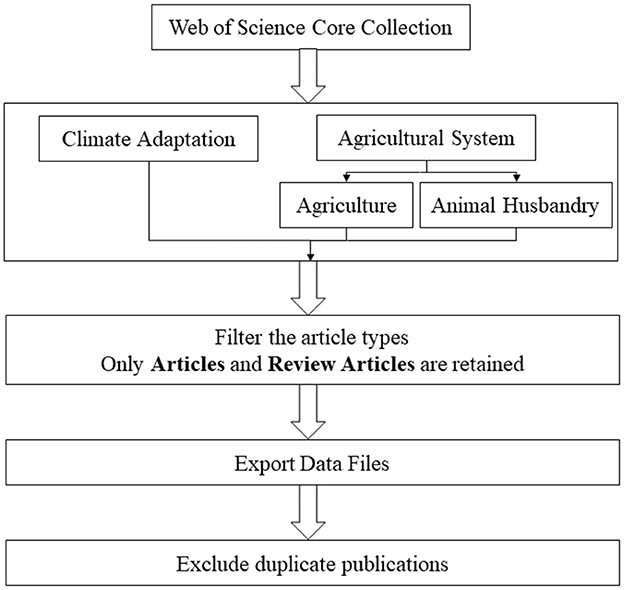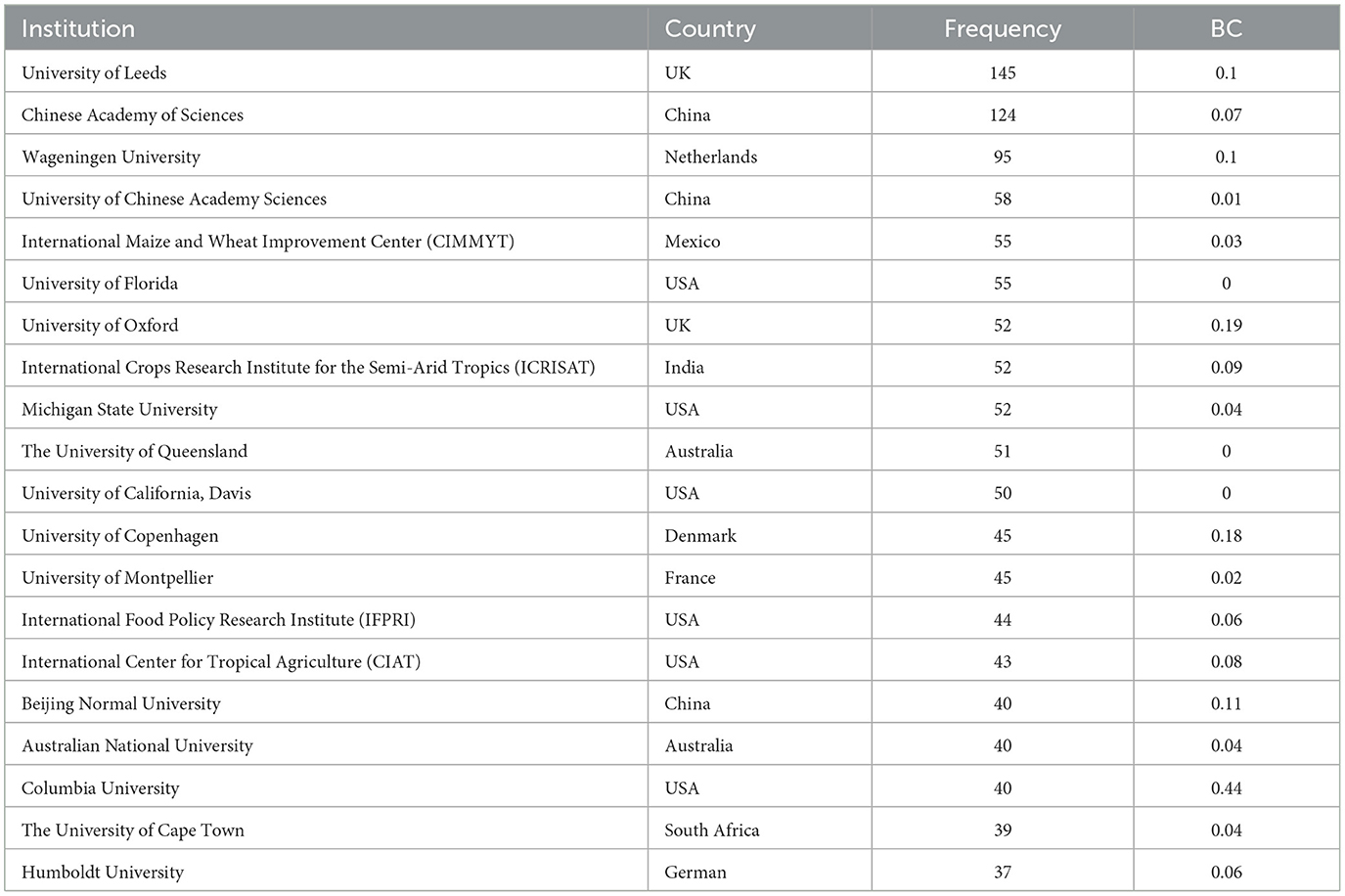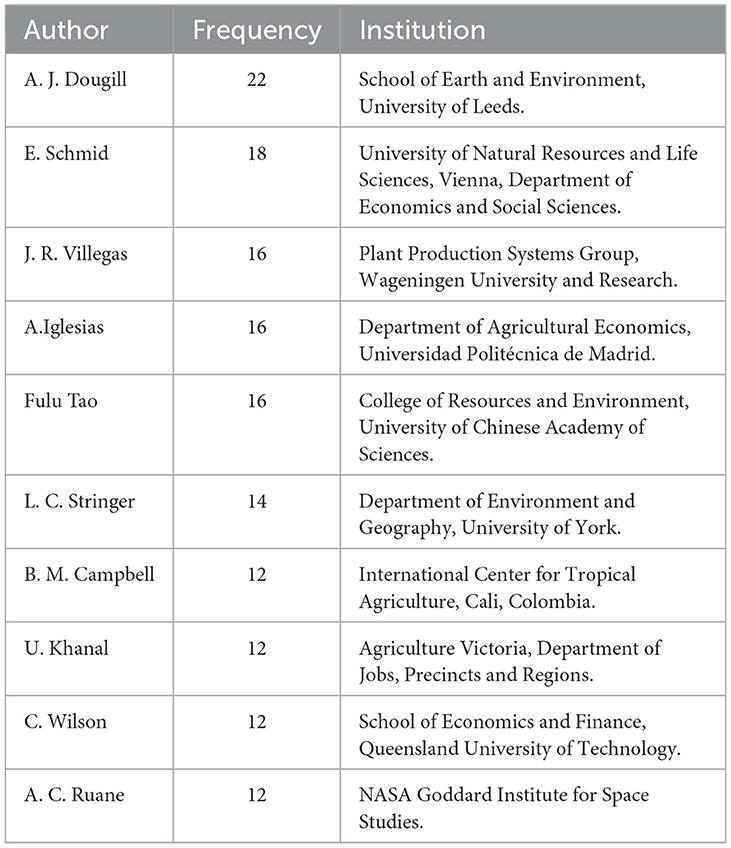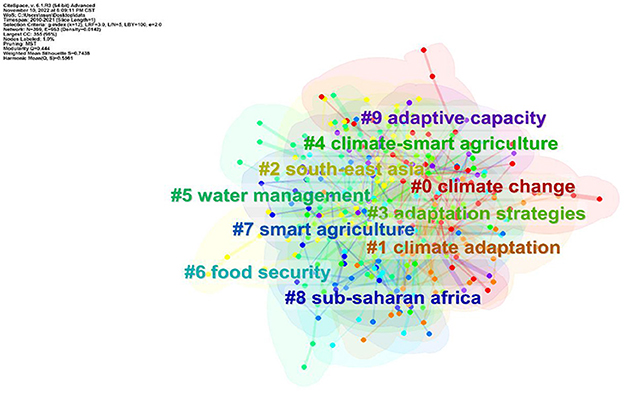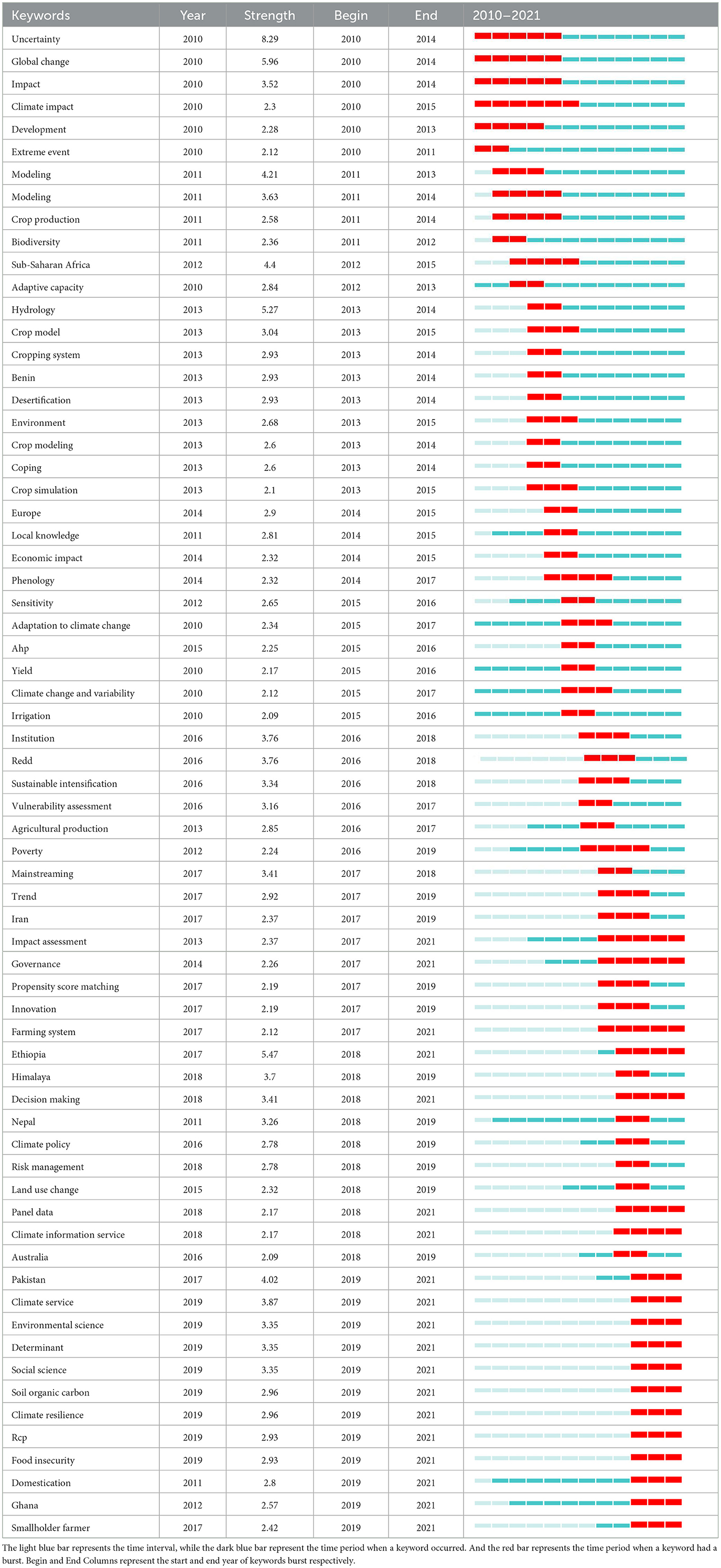- 1College of Economics and Management, Northeast Agricultural University, Harbin, China
- 2Development Research Center of Modern Agriculture, Northeast Agricultural University, Harbin, China
Agricultural system is highly dependent on the natural environment, thus even a slight climate change can have a significant impact on it. Climate change has already caused a series of problems for the agricultural system, which makes improving climate adaptation of the agricultural system extremely important. In order to clarify the current research status, cooperation network, research hotspots and trends in climate adaptation of the agricultural system, we adopt the bibliometric method via CiteSpace to analyze the data collected from the Web of Science (WoS) Core Collection. Through the analysis of a number of publications, we found that the current research in climate adaptation of the agricultural system has entered a rapid development stage. Moreover, the United State of America (USA) is the most impactful country with the most publications in this field. In terms of institutions, the University of Leeds contributes most to the research in climate adaptation of the agricultural system. And its faculty, A. J. Dougill, is the author who contribute most to this field. By cluster analysis and burst analysis, we confirmed conceptual studies, ecologically venerable areas, and climate adaptation strategies are the hotspot in climate adaptation of the agricultural system, while impact assessment, governance and decision-making, farming system, and climate information service are the research trend in this field. This review is expected to help researchers quickly grasp the research situation in climate adaptation of the agricultural system and provide a reference for future research in this field.
1. Introduction
Over the past few decades, there has been a large amount of evidence proving that climate change has brought about many negative impacts on the agricultural system, among which the impacts on agriculture and animal husbandry are the most terrible. Farming and livestock production are both extremely sensitive to the shock of climate change due to their dependence on the natural environment. Drought, abnormal precipitation, floods, soil degradation, pest, and disease caused by climate change have changed the farming environment, which led to damage to agricultural production. Based on the future climate change scenarios projected by IPCC (The Intergovernmental Panel on Climate Change), Calzadilla et al. (2013) used the GTAP-W model to analyze the data and found that climate change will bring huge losses to global food production. This result is not isolated, there are some empirical studies at different levels that have also confirmed it (Calzadilla et al., 2014; Moore and Lobell, 2014; Chen et al., 2016; Hannah et al., 2017). As for animal husbandry, feed reduction, extreme heat, and animal disease caused by climate change have brought about a noticeable shock to livestock production. There are numerous empirical studies have proved it as well (Seo and Mendelsohn, 2007; Zhao et al., 2014; Hristov et al., 2018). Products obtained from agriculture and animal husbandry are the main source of carbohydrates, protein, and nutrition for humans. Meanwhile, agriculture and animal husbandry have the potential to mitigate climate change and improve climate adaptation. In this context, the research in climate adaptation of the agricultural system has drawn great attention.
Many review studies have been carried out on climate adaptation of the agricultural system and there have been some remarkable outcomes. In terms of agriculture, Anwar et al. (2013) reviewed agriculture adapting to climate change and identified four major priority areas (information generation and dissemination, research and development in agricultural technology, policy reformulation to be adopted to farm level, and strengthening partnerships among the relevant stakeholders) to relax constraints to climate adaptation at the farm level. Dang et al. (2019) reviewed empirical studies on the factors affecting farmers' adaptation to climate change and found that financial and technical support is critical to farmers' responses to climate adaptation, while social and psychological factors should be taken into account when promoting climate adaptation. Vermeulen et al. (2018) reviewed 23 empirical case studies of agricultural transformation in response to climate change. The result showed that current transformative climate adaptation has barely generated a more resilient agricultural system and the improvement in governance, and suggested that more comprehensive and long-term adaptation planning approaches, as well as financial and technical assistance, are needed to enhance the effectiveness of climate adaptation practices. In terms of animal husbandry, Nardone et al. (2010) reviewed the impact of climate change on animal husbandry from the perspectives of animal health, reproduction, animal production, and livestock production system. The results indicated that climate change would bring great losses to animal husbandry, and suggested that better information and technological iteration is needed for guiding the evaluation of the livestock production system to adapt to climate change. Rojas-Downing et al. (2017) reviewed the impact of climate change on livestock and vice versa, as well as how animal husbandry adapts and mitigates climate change. It is found that climate change adversely affects livestock production in terms of feed, water, livestock diseases, heat stress, etc. and livestock production also affects climate through land use change, feed production, animal production, manure, processing, and transport at the same time. Besides, it is suggested that diversifying livestock animals (within species) and crop varieties shifted to crop-livestock mixed systems is one of the most promising adaptation measures. In their review, Gaughan et al. (2019) argued that climate change would bring challenges to livestock production and pressure on animal fertility performance and also argued that improving climate adaptation in animal husbandry requires the integration of animal breeding, nutrition, housing, and health, as well as improving animal comfort and performance.
According to the above literature, it is easy to find that the current review studies on climate adaption of the agricultural system mainly adopt the traditional review methods (scope review), and the bibliometric method is not usual, especially with visualization analysis. However, bibliometric analysis has unique advantages in grasping the current research statutes, hotspots, and trends. Thus, bibliometric analysis has been applied for reviewing climate adaptation because of its advantage and good fitness (Aleixandre-Benavent et al., 2017; Wang et al., 2018). Although there are bibliometric studies on climate adaptation, they have not been detailed to the field of agricultural system, as we mentioned above. In this study, based on the historically referenced publications, we conducted a bibliometric analysis with visualization via CiteSpace to analyze the number of publications, cooperation networks, research hotspots, and trends in climate adaptation of the agricultural system. Our objective is to assist researchers in getting a view of the current research situation quickly and provide a reference for further research in this field.
2. Data collection and method
2.1. Data collection
Web of Science (WoS) as the leading scientific citation search and analytical information platform, is widely used by researchers worldwide (Li et al., 2018). It is considered to be an ideal source for bibliometric investigation (van Leeuwen, 2006). Our data is collected from the Science Citation Index Expanded (SCIE) and Social Sciences Citation Index (SSCI) of the Web of Science Core Collection (WoSCC). In the search process, we restricted the search to the period between 2010 and 2021, and set TS = (Agriculture AND Climate Adaptation) OR TS = (Animal Husbandry AND Climate Adaptation), which means we use agriculture and climate adaptation or animal husbandry and climate adaptation as the topic. And then, we selected article types to articles and review articles. We conduct our search with Northeast Agricultural University Library and a total of 4,673 publications were returned. We stored these files in plain text file format to facilitate the next step of the bibliometric analysis (Figure 1 has shown the data selection process).
2.2. Research method
As a bibliometric method, knowledge maps or knowledge mapping are a wide variety of approaches to organize and structure knowledge resources, knowledge application steps, insightful concepts, expert networks, or communities of practice (Eppler, 2008). This method offers great advantages in terms of connecting experts, accessing knowledge in time, identifying knowledge assets, and identifying knowledge flow (Balaid et al., 2016). There are a variety of knowledge mapping tools in common use, including CiteSpace, Ucinet, VOSviewer, Bibexcel, etc. CiteSpace is a Java application developed by Chen (2004, 2013) from Drexel University for visualizing co-citation networks, including co-citation references, co-authors, and co-occurring keywords. Compared with other mapping tools, CiteSpace is applicable to a wide range of data formats, rich in mapping types, and has better visualization effects (Cobo et al., 2011). Therefore, CiteSpace was adopted to assist us in our bibliometric analysis.
The parameters were set as follows: (1) the timespan is from 2010 to 2021, and the slice length is 1, which means 1 year per slice; (2) in selection process, we set different g-index for each knowledge map, k = 100 for country and author cooperation network, k = 50 for institution cooperation network, as for keywords cluster analysis, k = 12 (k equals to the number of results extracted from each time slice); (3) the node type was set as country/institution/author/keyword; (4) the pruning for country and institution cooperation network is set as Pathfinder, for author is none, and for keywords cluster analysis is set as MST; (4) the result of keyword burst detection analysis presents using Table form.
3. Results
3.1. Overview of publications
For an overview of publications, the annual distribution and the trend of publications are shown in Figure 2. From 2010 to 2021, there is an overall upward trend in the number of publications in the field of climate adaptation of agricultural system. As it is shown in Figure 2, 2020 is a rising year with the fastest speed. We can conclude that 2020 is a rapid development year in climate adaptation of agricultural system and the research in climate adaptation of agricultural system has entered a new stage. Meanwhile, based on Web of Science Categories, we found that the research in climate adaptation of agricultural system is mainly focused on Environmental Sciences, Environmental Studies, Meteorology Atmospheric Sciences and Green Sustainable Science Technology.
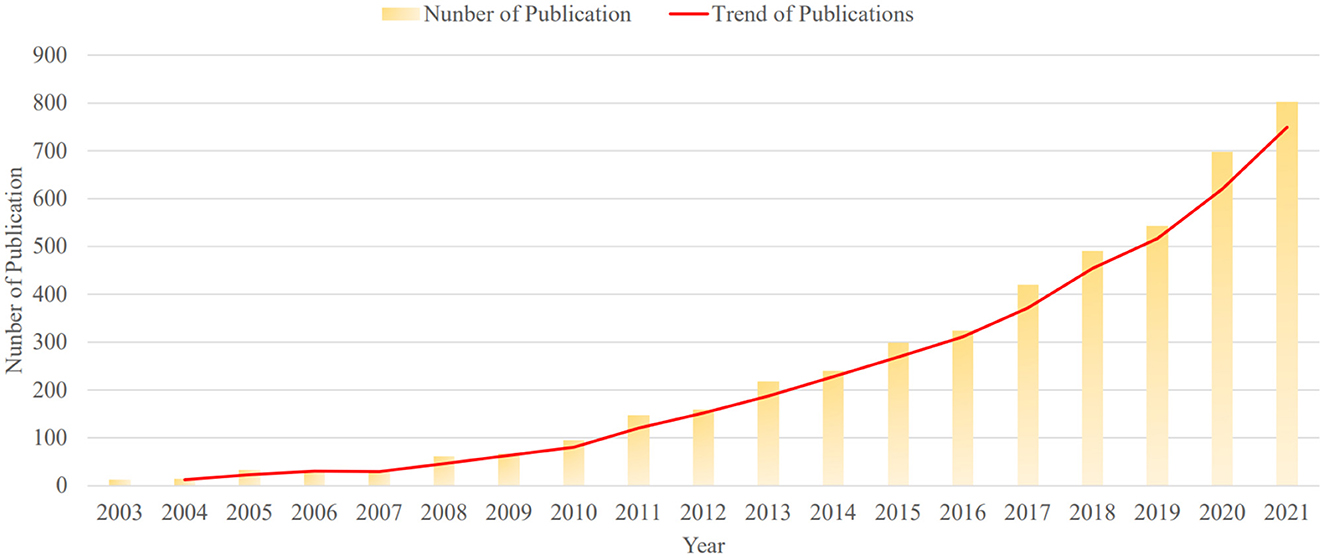
Figure 2. The number and trend of publications on climate adaptation of the agricultural system (2010–2021).
3.2. Cooperation networks
3.2.1. Country cooperation
As it is shown in Figure 3, the network of cooperated countries consists of 147 nodes and 202 links. The top ten countries contributing the most publications are listed in Table 1. The U.S. is the leading contributor with 1,136 publications, followed by England with 519 publications. Among developing countries, China and India are prominent, ranking 5th and 7th respectively in terms of the number of publication outputs. As for quantity, the number of publications from the United States far exceeds that of other countries, which indicates that the United States is the most active and influential in the field of climate adaptation of the agricultural system. In addition, Italy (0.15), England (0.14), Australia, and Switzerland (0.13) have the highest betweenness centralities and play an important role in international cooperation. Cooperation in most countries has been established since 2010, yet the weak linkage between countries in Figure 3 means a low level of cooperation.
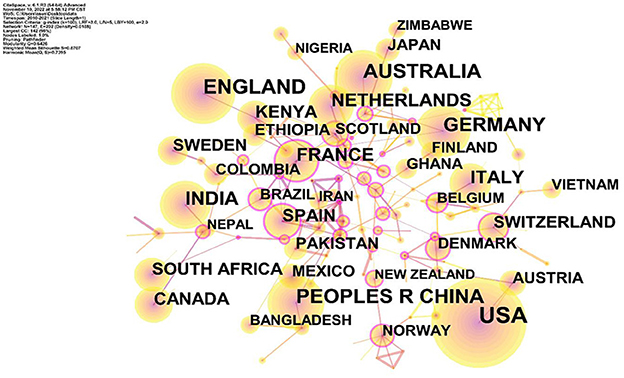
Figure 3. A visualization of the country cooperation network. Each node represent a country, the larger the node, the more publication that country has. The line represent the connection between countries, the thicker the line, the closer relationship and the lighter color of the line, the later connection.
3.2.2. Institution cooperation
For the period 2010 to 2021, the institution cooperation network consisted of 270 institutions and 349 links as shown in Figure 4. Compared to country cooperation networks, the structure of the institution cooperation network is relatively dense, and inter-institutional connections are stronger. Among all institutions, Columbia University (0.44) and the Potsdam Institute for Climate Impact Research in Germany (0.28) have the highest betweenness centralities. The top 20 institutions with the most publications are presented in Table 2. The University of Leeds, is in first place with 145 publications, and the Chinese Academy of Sciences and Wageningen University are followed. Interestingly, the results of the institutions' cooperation analysis demonstrated that research institutions from the U.S. make up the majority of the top 20 institutions with the most publications, consistent with our findings in our country's cooperation analysis. University of Florida, Michigan State University, University of California, Davis, International Food Policy Research Institute, International Center for Tropical Agriculture, and Columbia University ranked 6, 9, 11, 14, 15, and 18, respectively. In addition, as we can see from Figure 4, all the impactful institutions' cooperate with each other, and the institutions from the same country have a stronger connection than the institution from different countries.
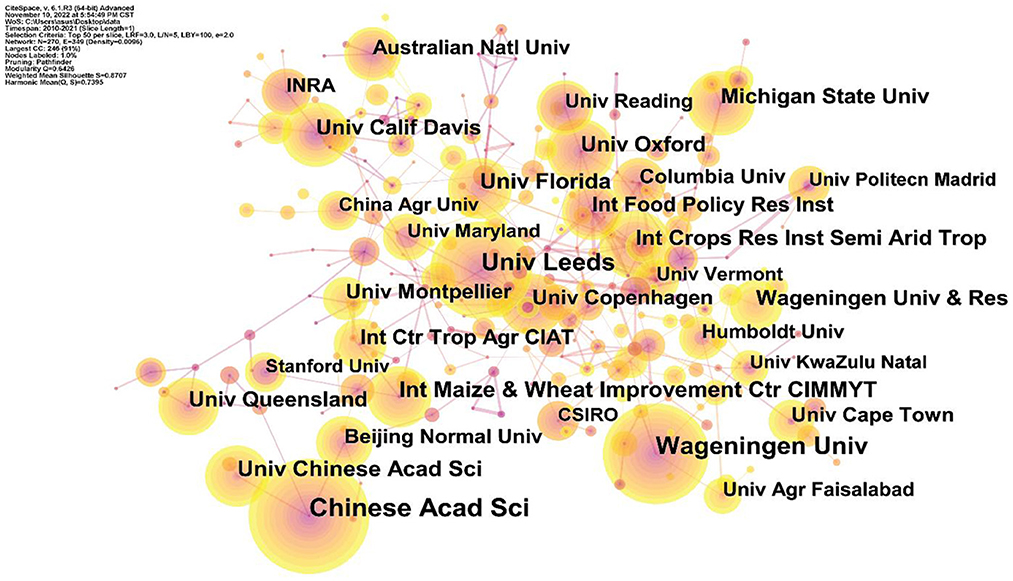
Figure 4. A visualization of the institution cooperation network. Each node represent a institution, the larger the node, the more publication that institution has. The line represent the connection between insitutions, the thicker the line, the closer relationship and the lighter color of the line, the later connection.
3.2.3. Author cooperation
As it is shown in Figure 5, the author cooperation network contributing to climate adaptation of the agricultural system consisted of 1,633 authors and 2,695 links. We can see that there is a large number of participants and close collaboration in the field. In addition, we are able to consume that there are many researchers from different fields involved in this research direction. A. J. Dougill, from the School of Earth and Environment, University of Leeds, UK, has the highest frequency of collaboration with other authors in the cooperation network as you can see in Table 3. The affiliations of other impactful authors are distributed around the world. Currently, most of the authors are still working in close collaboration for further research on climate adaptation of the agricultural system.
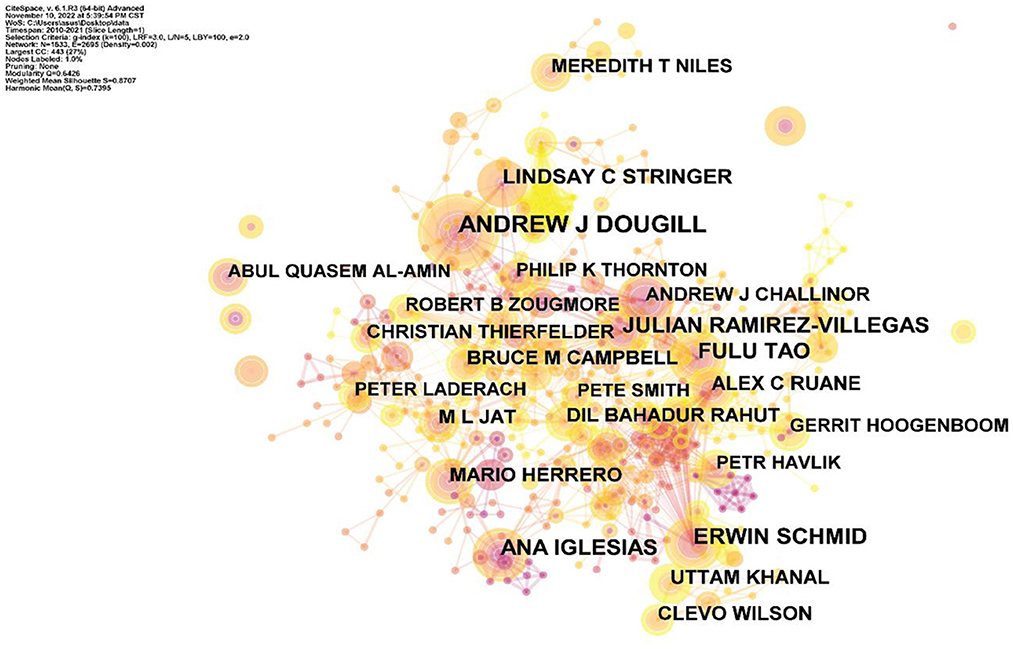
Figure 5. A visualization of the author cooperation network. Each node represent an author, the larger the node, the more publication that author has. The line represent the connection between authors, the thicker the line, the closer relationship and the lighter color of the line, the later connection.
3.3. Research hotspots and trends
3.3.1. Research hotspots
Keywords allow us to quickly capture the main content of the article, and it is able to reflect the hotspot in a research field. Figure 6 shows the keyword cluster in climate adaptation of the agricultural system, which can help us recognize the research interest and hotspot in this field. According to Figure 6, we summarized three main research hotspots:
1) Conceptual studies
Based on the keyword cluster network analyzed by CiteSpace, the conceptual studies on climate adaptation of the agricultural system mainly focus on # 0 climate change, # 1 climate adaptation, # 6 food security, and # 9 adaptive capacity. The concept of climate adaptation was put forward in the context of climate change, and the key factor in improving climate adaptation is ensuring food security. Therefore, adaptive capacity is proposed to evaluate and manage climate adaptation. The definition of adaptive capacity is essential to assess climate adaptation, but it is also complex and vague, which makes it difficult to pin down. IPCC, the leading international organization for assessing the impact of climate change, defined the adaptive capacity as the ability of systems, institutions, humans, and other organisms to adjust to potential damage, take advantage of opportunities, or respond to consequences (AR5, 2014). Engle (2011) reviewed the concepts and assessment approaches of adaptive capacity, and acknowledged the centrality of the concept of adaptive capacity and its unique position in improving linkages between vulnerability and resilience research. Both vulnerability and resilience frameworks can help foster the applicability of adaptive capacity in climate adaptation research.
2) Ecologically venerable areas
The impact of climate change on ecologically venerable areas is most noticeable. Through keyword cluster analysis, it is found that Southeast Asia and sub-Saharan Africa are hotspots. Climate change will bring warming, abnormal precipitation, floods, droughts, wind storms, and other extreme weather, causing many problems to the agricultural system (Deng et al., 2022). In Southeast Asia, a study by Thirumalai et al. (2017) showed that climate change had exacerbated extreme temperatures and adversely affected agricultural production in Southeast Asia. A study by Loo et al. (2015) indicated that climate change would affect the distribution of monsoon rainfall in Southeast Asia, resulting in floods in some areas and leading to serious consequences on agricultural production. Regarding to sub-Saharan Africa, is the most vulnerable region in the world to climate change, and it is extremely sensitive to changes in weather and climate variables (like temperature, precipitation, and light) (Kotir, 2011). Extreme temperatures and reduced rainfall brought by climate change in sub-Saharan Africa will have disastrous results in local agricultural and livestock production (Müller et al., 2014; Serdeczny et al., 2017). Therefore, Southeast Asia and sub-Saharan Africa have become research hotspots due to their vulnerability to climate change.
3) Climate adaptation strategies
Improving climate adaptation is one of the issues that the agricultural system must face. Figure 6 shows that #3 adaptation strategies, #4 climate-smart agriculture, #5 water management, and #7 smart agriculture are research hotspots. Smart agriculture and climate-smart agriculture are both adaptation strategies, while water management is one practice of smart agriculture and climate-smart agriculture. In a literature review by Mizik (2021) smart agriculture and climate-smart agriculture are discussed and distinguished and it claims that smart agriculture is a comprehensive adaptation strategy involving small-scale farmers, weather and market information, etc. while climate-smart agriculture is included in smart agriculture. Water management is one of the practices of smart agriculture and climate-smart agriculture to adapt and adjust the agricultural system in response to climate change.
3.3.2. Research trends
The changes in keywords can reflect the latest research topics and are able to help the researcher to grasp the research trends. Keyword burst detection (Table 4) illustrated the research hotspots in a specific period. By analyzing the keywords and their corresponding red lines (heat bar, representing the strongest period of burst), we conclude the current research trends in climate adaptation of the agricultural system:
1) Impact assessment
The impact of climate change on the agricultural system is sophisticated and there are a large number d studies focusing on the impact assessment of climate change. Nardone et al. (2010) followed the theory of global warming and reviewed the effect of climate change on livestock. The result indicated that climate change would harm animal health, reproduction, and animal production. Calzadilla et al. (2013) assess the impact of climate change on global agriculture based on the predicted changes in the magnitude and distribution of global precipitation, temperature, and river flow under the IPCC SRES A1B and A2 scenarios and found that climate change could modify regional water endowments and soil moisture, with negative impacts on global agricultural production, welfare, and GDP. Aggarwal et al. (2019) conducted a systematic review, comparing the projected yield with observed yield, and found that technology growth is not taken into account in existing impact assessments of climate change, which provide a reference for optimizing current impact assessment methods. Since agricultural production is extremely dependent on the natural environment and sensitive to climate change, it is of great significance to assess the impact of climate change for realizing sustainable development and improving climate adaptation of the agricultural system.
2) Governance and decision making
Considering the cannot-ignored impact of climate change, improving climate adaptation of the agricultural system is the priority in global governance. Governance and decision-making are forefront topics in the field of climate adaptation of agricultural systems based on the keyword burst detection via CiteSpace. Joly et al. (2022) proposed that applying appropriate modeling methods in decision-making is beneficial to livestock production in response to external climate shocks. Valencia et al. (2022) analyzed the problems of the agriculture network in urban governance and found identifying the priority by clustering analysis from environmental, social, and economic is useful for better governance. This decision-making method function well under climate change scenarios. Ashton (2022) developed a framework to evaluate and organize governance systems that influence natural climatic solutions in agriculture to achieve the intended benefits of natural climatic solutions and this framework is used to assess the Canadian agriculture sector's efforts to promote natural climatic solutions, finding that Canada's current governance ecosystem meets the criteria to some extent. Adaptation to environmental change is an inevitable process of human evolution. Global warming, uneven distribution of precipitation, frequent extreme weather, and other problems caused by climate change have increased the vulnerability of an agricultural system, which requires intervention by governments and policymakers. In the context of climate uncertainty, governance and decision-making are challenging, so research on governance and decision-making in the field of climate adaptation of the agricultural system is extremely necessary to improve climate adaptation in governance.
3) Farming system and climate information service
The usage of climate information services is considered a key step toward increasing climate adaptation of the agricultural system to the threat of climate change. Djido et al. (2021) take Ghana as an example and explore the relationship between the climate information service and the adoption of climate-smart agriculture practices, finding that the usage of climate information services has a positive impact on the adoption of water management and multiple cropping practices for farmers. Anshul et al. (2022) carried out a study in Bihar, India to investigate the role of climate information in building resilience. The results showed that farmers benefit from climate information and can increase climate resilience by adjusting production practices. Warner et al. (2022) conducted a systematic review of the literature concerning climate information services to identify the common factors that affect the usage of climate information services by farmers and agriculture practitioners. It was found that user participation and engagement was the most frequently mentioned factor. Meanwhile, trust and credibility of climate information services and their providers, multi-modal communication channels, and timely delivery are also the factors that are most often cited as influencing the usage of climate information services. The application of climate information services in agricultural systems will help alleviate climate threats to agricultural systems and thus improve the climate adaptation of the agricultural system. Therefore, there are real demands and prospects for research on relevant topics.
4. Discussion
By the analysis of the number of publications, cooperation networks, research hotspots, and research trends in the field of climate adaptation of the agricultural system, we identified some problems for future research. As for cooperation, there is only a little cross-country cooperation, and cooperation among institutions is often limited within a country. Besides, the major contribution in this field is still from developed countries based on publication counting. This is not denying the efforts that developing countries made to mitigate and adapt to climate change. On the contrary, developing countries have made a lot of contributions in this regard, though we can observe from the evidence that the main responsibility for climate change lies with the developed countries with high greenhouse gas emissions, and the consequences of climate change tend to be borne by the developing countries whose agricultural sector are the pillar of their economy (Roberts, 2001; Mertz et al., 2009; Hansen and Cramer, 2015; Althor et al., 2016). In the co-occurrence analysis at the country level, we found that China and India have a large number of publications in this field, ranking 5th and 7th respectively. In addition, through reviewing the previous peer-reviewed articles, we can see evidence shows that developing countries have made many efforts to improve climate adaptation. Since the United Nations Framework Convention on Climate Change was agreed upon in 1992, there have been studies on the efforts made by developing countries, which have confirmed the contribution of developing countries to mitigate climate change (Reid and Goldemberg, 1998). Earlier this decade the Center for Climate Energy Solutions (2002) examined six developing countries (Brazil, China, India, Mexico, South Africa and Turkey) to mitigate climate change. The results showed that over the past three decades, the actions taken by these six countries had reduced the growth of their combined annual greenhouse gas emissions by nearly 300 million tons a year (n.d.). Studies in recent years have also shown that developing countries are making effort to improve climate adaptation. For example, the Nigerian government is trying to adjust the energy mix to mitigate climate change (Elum and Momodu, 2017). In addition to governments, individuals are also taking action to mitigate climate change. Tan-Soo et al. (2023) found that individuals and households in China are also taking adaptation actions to mitigate climate change. Back to international cooperation, we hope that developed countries with more academic resources will cooperate more with developing countries, especially those in ecologically vulnerable areas (such as those countries around the equator that are more sensitive to climate change).
In terms of the research trend, there is an interesting trend that the current research hotspots are shifting from natural sciences to social sciences. The reason why this shifting is happening is sophisticated. We assumed that there was a time lag between impact of climate change on natural system and on economic and social aspects, even though it was inevitable that climate change would affect the economy and society eventually. Moreover, as the development of all studies is gradual, we thought the reason why the concentration of research in climate adaptation of agricultural system is transferring from natural system to social and economic perspectives might be people had a better understanding of natural science characteristics of climate change so that they could attribute more economic and social phenomena to climate change. As climate change effects are complex, as well as the agricultural system, it is necessary to focus beyond the natural production environment and take economic and social factors into consideration. Via the burst keyword analysis, we found that governance, social science, and food insecurity have all become research frontiers. These studies on social science will be essential if the agricultural system wants to improve climate adaptation comprehensively. Consequently, improving climate adaptation from natural, economic, and social aspects can as an effective approach to achieving sustainable development for the agricultural system under complicated climate scenarios.
Although analysis by knowledge mapping and bibliometric methods can get some meaningful results, it still has some limitations. First of all, most articles from the Web of Science are relevant to the sole language (English), so relevant studies written in other languages are ignored. Secondly, due to the large number of data we collected, the difference in presenting formats of authors' information greatly challenged statistical analysis. Thirdly, as the database of articles is constantly updated, we can never represent the latest research status. Fourthly, we do not deny that more scope reviews and systematic reviews are necessary in order to more accurately grasp the research situation in relevant subfields.
5. Conclusion
Based on the core database of the Web of Science, this paper used CiteSpace to analyze the literature in the field of climate adaptation of agricultural systems from 2010 to 2021. It is found that the current research in this field showed a rising trend, and the development has been particularly rapid in recent years, and the main research catalogs environmental sciences, environmental studies, meteorology atmospheric sciences, and green sustainable science technology. In terms of cooperation networks, at the country level, the United States has far more publications than other countries and has a great influence in this field. Furthermore, most countries have established cooperation. Italy, the United Kingdom, Australia, and Switzerland are more involved in international cooperation and play an important role in the connection between countries and international cooperation in this field. At the institutional level, the institutions have built a strong connection. The University of Leeds has published a large number of papers in this field, and Columbia University and the Potsdam Institute for Climate Impact Research have played an active role in institutional cooperation. At the author level, American scholars were most involved, and A. J. Dougill from the University of Leeds collaborated with other authors the most frequently. Through the keyword cluster, we concluded that the current research hotspots in the field of climate adaptation of agricultural systems are conceptual studies, ecologically venerable areas, climate adaptation strategies. In combination with keyword burst analysis, we thought the research trends in this filed would be impact assessment, governance and decision-making, and farming system and climate information service. Interestingly, we found that the focus of research is shifting from the natural systems to the social and economic dimensions.
Data availability statement
The original contributions presented in the study are included in the article/supplementary material, further inquiries can be directed to the corresponding author.
Author contributions
BJ, XD, and HC contributed to conception and design of the study. LC and WT organized the database. XD and HC performed the statistical analysis and wrote the first draft of the manuscript. BJ, XD, HC, LC, and WT reviewed the manuscript. All authors contributed to manuscript revision, read, and approved the submitted version.
Funding
This research was funded by National Natural Science Foundation of China (72203034 and 71640017), the Philosophy and Social Science Planning General Project of Heilongjiang Province (22JYB223), and Natural Science Foundation of Heilongjiang Province (LH2021G002).
Acknowledgments
We would like to express our gratitude to Prof. Chaomei Chen for inventing CiteSpace and making it available to the public for free use.
Conflict of interest
The authors declare that the research was conducted in the absence of any commercial or financial relationships that could be construed as a potential conflict of interest.
Publisher's note
All claims expressed in this article are solely those of the authors and do not necessarily represent those of their affiliated organizations, or those of the publisher, the editors and the reviewers. Any product that may be evaluated in this article, or claim that may be made by its manufacturer, is not guaranteed or endorsed by the publisher.
References
Aggarwal, P., Vyas, S., Thornton, P., Campbell, B. M., and Kropff, M. (2019). Importance of considering technology growth in impact assessments of climate change on agriculture. Glob. Food Sec. 23, 41–48. doi: 10.1016/j.gfs.2019.04.002
Aleixandre-Benavent, R., Aleixandre-Tudó, J. L., Castelló-Cogollos, L., and Aleixandre, J. L. (2017). Trends in scientific research on climate change in agriculture and forestry subject areas (2005–2014). J. Clean. Prod. 147, 406–418. doi: 10.1016/j.jclepro.2017.01.112
Althor, G., Watson, J. E. M., and Fuller, R. A. (2016). Global mismatch between greenhouse gas emissions and the burden of climate change. Sci. Rep. 6:20281. doi: 10.1038/srep20281
Anshul, A., Mitesh, S., Srinivasan, G., Buizer, J., Finan, T., Singh, K. K., et al. (2022). Integrating climate information into decision making for building resilience: a case study on farming communities in Bihar, India. Clim. Serv. 28:100328. doi: 10.1016/j.cliser.2022.100328
Anwar, M. R., Liu, D. L., Macadam, I., and Kelly, G. (2013). Adapting agriculture to climate change: a review. Theor. Appl. Climatol. 113, 225–245. doi: 10.1007/s00704-012-0780-1
Ashton, L. (2022). A framework for promoting natural climate solutions in the agriculture sector. Land Use Policy. 122:106382. doi: 10.1016/j.landusepol.2022.106382
Balaid, A., Abd Rozan, M. Z., Hikmi, S. N., and Memon, J. (2016). Knowledge maps: a systematic literature review and directions for future research. Int. J. Inform. Manag. 36, 451–475. doi: 10.1016/j.ijinfomgt.2016.02.005
Calzadilla, A., Rehdanz, K., Betts, R., Falloon, P., Wiltshire, A., and Tol, R. S. J. (2013). Climate Change impacts on global agriculture. Clim. Change 120, 357–374. doi: 10.1007/s10584-013-0822-4
Calzadilla, A., Zhu, T., Rehdanz, K., Tol, R. S. J., and Ringler, C. (2014). Climate change and agriculture: impacts and adaptation options in South Africa. Water Resour. Econ. 5, 24–48. doi: 10.1016/j.wre.2014.03.001
Center for Climate and Energy Solutions (2002). Climate Change Mitigation in Developing Countries: Brazil, China, India, Mexico, South Africa, and Turkey.
Chen, C. (2004). Searching for intellectual turning points: progressive knowledge domain visualization. Proc. Natl. Acad. Sci. 101, 5303–5310. doi: 10.1073/pnas.0307513100
Chen, C. (2013). The Structure and Dynamics of Scientific Knowledge in Mapping Scientific Frontiers: The Quest for Knowledge Visualization. Chen, C., Editor. London: Springer, 163–99. doi: 10.1007/978-1-4471-5128-9
Chen, S., Chen, X., and Xu, J. (2016). Impacts of climate change on agriculture: evidence from China. J. Environ. Econ. Manag. 76, 105–124. doi: 10.1016/j.jeem.2015.01.005
Cobo, M. J., López-Herrera, A. G., Herrera-Viedma, E., and Herrera, F. (2011). Science mapping software tools: review, analysis, and cooperative study among tools. J. Am. Soc. Inform. Sci. Technol. 62, 1382–1402. doi: 10.1002/asi.21525
Dang, H. L., Li, E., Nuberg, I., and Bruwer, J. (2019). Factors influencing the adaptation of farmers in response to climate change: a review. Clim. Dev. 11, 765–774. doi: 10.1080/17565529.2018.1562866
Deng, X., Yang, Q., Zhang, D., and Dong, S. (2022). Application of conservation tillage in China: a method to improve climate resilience. Agronomy. 12, 1575. doi: 10.3390/agronomy12071575
Djido, A., Zougmoré, R. B., Houessionon, P., Ouédraogo, M., Ouédraogo, I., and Seynabou Diouf, N. (2021). To what extent do weather and climate information services drive the adoption of climate-smart agriculture practices in Ghana? Clim. Risk Manag. 32:100309. doi: 10.1016/j.crm.2021.100309
Elum, Z. A., and Momodu, A. S. (2017). Climate change mitigation and renewable energy for sustainable development in nigeria: a discourse approach. Renew. Sust. Energy Rev. 76, 72–80. doi: 10.1016/j.rser.2017.03.040
Engle, N. L. (2011). Adaptive capacity and its assessment. Glob. Environ. Change 21, 647–656. doi: 10.1016/j.gloenvcha.2011.01.019
Eppler, M. J. (2008). A process-based classification of knowledge maps and application examples. Knowl. Process Manag. 15, 59–71. doi: 10.1002/kpm.299
Gaughan, J. B., Sejian, V., Mader, T. L., and Dunshea, F. R. (2019). Adaptation strategies: ruminants. Anim. Front. 9, 47–53. doi: 10.1093/af/vfy029
Hannah, L., Donatti, C. I., Harvey, C. A., Alfaro, E., Rodriguez, D. A., Bouroncle, C., et al. (2017). Regional modeling of climate change impacts on smallholder agriculture and ecosystems in Central America. Clim. Change 141, 29–45. doi: 10.1007/s10584-016-1867-y
Hansen, G., and Cramer, W. (2015). Global distribution of observed climate change impacts. Nat. Clim. Change, 5, 182–185. doi: 10.1038/nclimate2529
Hristov, A. N., Degaetano, A. T., Rotz, C. A., Hoberg, E., Skinner, R. H., Felix, T., et al. (2018). Climate change effects on livestock in the Northeast US and strategies for adaptation. Clim. Change 146, 33–45. doi: 10.1007/s10584-017-2023-z
Joly, F., Sabatier, R., Tatin, L., Mosnier, C., Ahearn, A., Benoit, M., et al. (2022). Adaptive decision-making on stocking rates improves the resilience of a livestock system exposed to climate shocks. Ecol. Modell. 464:109799. doi: 10.1016/j.ecolmodel.2021.109799
Kotir, J. H. (2011). Climate change and variability in Sub-Saharan Africa: a review of current and future trends and impacts on agriculture and food security. Environ. Dev. Sustain. 13, 587–605. doi: 10.1007/s10668-010-9278-0
Li, K., Rollins, J., and Yan, E. (2018). Web of science use in published research and review papers 1997–2017: a selective, dynamic, cross-domain, content-based analysis. Scientometrics 115, 1–20. doi: 10.1007/s11192-017-2622-5
Loo, Y. Y., Billa, L., and Singh, A. (2015). Effect of climate change on seasonal monsoon in asia and its impact on the variability of monsoon rainfall in Southeast Asia. Geosci. Front. 6, 817–823. doi: 10.1016/j.gsf.2014.02.009
Mertz, O., Halsnæs, K., Olesen, J. E., and Rasmussen, K. (2009). Adaptation to climate change in developing countries. Environ. Manag. 43, 743–752. doi: 10.1007/s00267-008-9259-3
Mizik, T. (2021). Climate-smart agriculture on small-scale farms: a systematic literature review. Agronomy, 11:1096. doi: 10.3390/agronomy11061096
Moore, F. C., and Lobell, D. B. (2014). Adaptation potential of european agriculture in response to climate change. Nat. Clim. Change, 4, 610–614. doi: 10.1038/nclimate2228
Müller, C., Waha, K., Bondeau, A., and Heinke, J. (2014). Hotspots of climate change impacts in Sub-Saharan Africa and implications for adaptation and development. Glob. Change Biol. 20, 2505–2517. doi: 10.1111/gcb.12586
Nardone, A., Ronchi, B., Lacetera, N., Ranieri, M. S., and Bernabucci, U. (2010). Effects of climate changes on animal production and sustainability of livestock systems. Livestock Sci. 130, 57–69. doi: 10.1016/j.livsci.2010.02.011
Reid, W. V., and Goldemberg, J. (1998). Developing countries are combating climate change: actions in developing countries that slow growth in carbon emissions. Energy Policy 26, 233–237. doi: 10.1016/S0301-4215(97)00137-7
Roberts, J. T. (2001). Global inequality and climate change. Soc. Nat. Resour. 14, 501–509. doi: 10.1080/08941920118490
Rojas-Downing, M. M., Nejadhashemi, A. P., Harrigan, T., and Woznicki, S. A. (2017). Climate change and livestock: impacts, adaptation, and mitigation. Clim. Risk Manag. 16, 145–163. doi: 10.1016/j.crm.2017.02.001
Seo, S. N., and Mendelsohn, R. (2007). Climate Change Impacts on Animal Husbandry in Africa : A Ricardian Analysis. Washington, DC: World Bank. doi: 10.1596/1813-9450-4261
Serdeczny, O., Adams, S., Baarsch, F., Coumou, D., Robinson, A., Hare, W., et al. (2017). Climate change impacts in Sub-Saharan Africa: from physical changes to their social repercussions. Reg. Environ. Change 17, 1585–1600. doi: 10.1007/s10113-015-0910-2
Tan-Soo, J. -S., Li, J., and Qin, P. (2023). Individuals' and households' climate adaptation and mitigation behaviors: a systematic review. China Econ. Rev. 77:101879. doi: 10.1016/j.chieco.2022.101879
Thirumalai, K., DiNezio, P. N., Okumura, Y., and Deser, C. (2017). Extreme temperatures in Southeast Asia caused by el niño and worsened by global warming. Nat. Commun. 8:15531. doi: 10.1038/ncomms15531
Valencia, A., Qiu, J., and Chang, N. -B. (2022). Integrating sustainability indicators and governance structures via clustering analysis and multicriteria decision making for an urban agriculture network. Ecol. Indicators 142:109237. doi: 10.1016/j.ecolind.2022.109237
van Leeuwen, T. (2006). The application of bibliometric analyses in the evaluation of social science research. who benefits from it, and why it is still feasible. Scientometrics 66, 133–154. doi: 10.1007/s11192-006-0010-7
Vermeulen, S. J., Dinesh, D., Howden, S. M., Cramer, L., and Thornton, P. K. (2018). Transformation in practice: a review of empirical cases of transformational adaptation in agriculture under climate change. Front. Sustain. Food Systems, 2:65. doi: 10.3389/fsufs.2018.00065
Wang, Z., Zhao, Y., and Wang, B. (2018). A bibliometric analysis of climate change adaptation based on massive research literature data. J. Clean. Prod. 199, 1072–1082. doi: 10.1016/j.jclepro.2018.06.183
Warner, D., Moonsammy, S., and Joseph, J. (2022). Factors that influence the use of climate information services for agriculture: a systematic review. Clim. Serv. 28:100336. doi: 10.1016/j.cliser.2022.100336
Keywords: climate adaptation, climate change, agricultural system, animal husbandry, bibliometric analysis, CiteSpace, knowledge mapping
Citation: Jiang B, Deng X, Chen H, Cui L and Tang W (2023) Research trends and hotspots in climate adaptation of the agricultural system: A bibliometric analysis. Front. Sustain. Food Syst. 7:1158904. doi: 10.3389/fsufs.2023.1158904
Received: 04 February 2023; Accepted: 07 March 2023;
Published: 27 March 2023.
Edited by:
Yuchuan Fan, University of Florida, United StatesReviewed by:
Nan Xu, University of Florida, United StatesSen Li, Farmland Irrigation Research Institute (CAAS), China
Copyright © 2023 Jiang, Deng, Chen, Cui and Tang. This is an open-access article distributed under the terms of the Creative Commons Attribution License (CC BY). The use, distribution or reproduction in other forums is permitted, provided the original author(s) and the copyright owner(s) are credited and that the original publication in this journal is cited, in accordance with accepted academic practice. No use, distribution or reproduction is permitted which does not comply with these terms.
*Correspondence: Xiaoshang Deng, YTA4MjAwODczQG5lYXUuZWR1LmNu; ZHhzMDUxN0BvdXRsb29rLmNvbQ==
 Bing Jiang
Bing Jiang Xiaoshang Deng
Xiaoshang Deng Hongbo Chen
Hongbo Chen Lihang Cui
Lihang Cui Wenjie Tang
Wenjie Tang